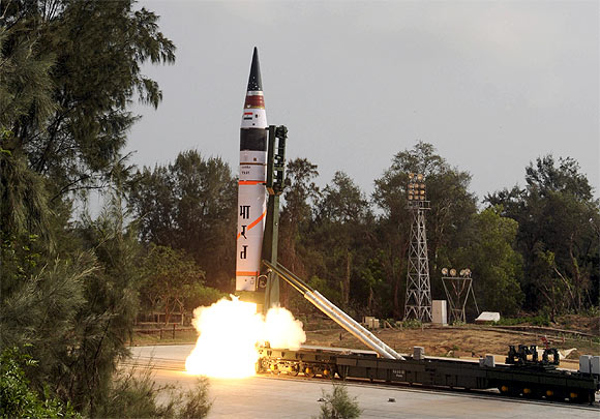Riding high on the success of 30 missions in last three months, India plans to deploy its longest range most potent nuclear-capable ballistic missile Agni-V this year. With the 5,000-plus km range missile in its arsenal, India is the eighth nation in the world to have ICBM capabilities.
Although the defence strategists had planned an early induction of Agni-V compared to its medium and intermediate range siblings, the Chinese aggression along the Line of Actual Control (LAC) has fast-tracked the process.
Defence source said the indigenously developed game-changer missile, which is undergoing its pre-induction trials, would be finally deployed at strategic locations as selected by the armed forces. The canisterised Agni-V gives the forces the requisite operational flexibility to swiftly transport as per requirement on a short notice.
“The induction process of the missile, which is under serial production, has already started. It would be officially deployed with the final induction trial in next three to four months. The deployment will pave the way for development of more long range missiles, which are on the drawing board,” the source told The Express.
A symbol of DRDO’s technological excellence, the missile equipped with highly accurate ring laser gyro based inertial navigation and most modern micro inertial navigation system with advanced compact avionics is capable of taking down targets in whole of Asia and half of Europe.
India has also planned to test some new technologies, including the multiple independently targetable re-entry vehicles (MIRV), which allows long range missiles to deliver multiple warheads programmed to destroy different targets hundreds of km away from each other and alternatively launch more than one warhead assigned to one target.
This apart, several missions, including maiden flight trial of beyond visual range Astra Mk II having a strike range of over 150 km, user trial of guided Pinaka rockets and developmental test of an advanced version of home grown subsonic cruise missile Nirbhay have been planned in early 2021.
“Development of new Airborne Early Warning and Control (AEW&C) planes and underwater unmanned vessels (UUVs) along with the Light Combat Aircraft (LCA) Mk-II will be the areas of focus for the DRDO this year,” said a defence official.
The DRDO has already received orders for development of AEW&C Block 2 aircraft under a Rs 10,500 crore project.
Source: Indian Express
You may also like
-
IAF Aircraft Set Course For Exercise Eastern Bridge VII At Oman
-
IAF Set To Host The Indian Defence Aviation Exposition-II At Jodhpur
-
Defence Secretary to co-chair 5th India-Philippines Joint Defence Cooperation Committee meeting in Manila
-
Simultaneous Launch Of ‘malpe And Mulki’, Fourth And Fifth Ships Of Asw Swc (Csl) Project
-
Aatmanirbharta in Defence: MoD signs Contract with HAL for 240 AL-31FP Aero Engines for Su-30MKI Aircraft
